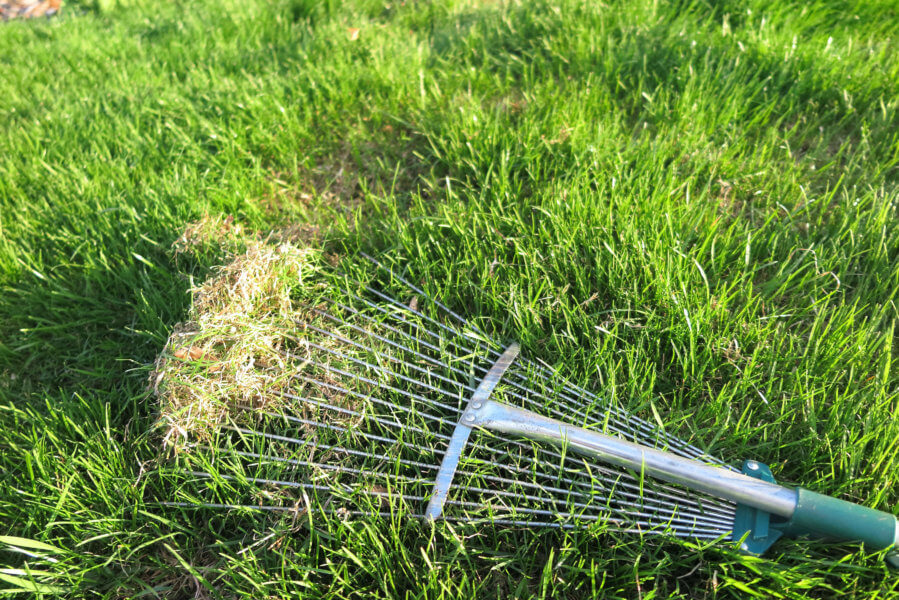
The Importance of Dethatching and Aeration
To keep your Florida lawn looking its best over the years, it is important to keep it in good health. This requires ongoing care and maintenance, including dethatching and aeration. Often overlooked by homeowners, these two are among the most important tasks for helping your lawn thrive. Here’s what you need to know about dethatching and aeration, along with their benefits and why they are so important.
How Dethatching Works
Thatch is a layer of grass clippings, leaves, twigs, small pieces of trash and other debris that can accumulate in your lawn. In small amounts, thatch can be beneficial to your lawn. As it decomposes, it imbues the soil with valuable nutrients that contribute to the overall health of your grass. However, when thatch gets too thick, it essentially chokes off the underlying lawn, starving it of sunlight, water, and air.
Dethatching is a relatively easy process, though it does require a little bit of work. You’ll need a thatching rake, which features metal bristles spaced widely apart. You can pick one up at your local home improvement, gardening, or hardware store. Drag the rake across your lawn, making sure to reach down underneath the thatch so you can pull it up as smoothly as possible. Work your way across the lawn systematically to ensure you don’t miss anything.
Although there are power-raking machines on the market, it is better to handle this task manually. This type of equipment can be harsh on the grass, leaving it damaged and stressed, rather than refreshed. Manual dethatching will take a bit longer, but it will be much easier on your grass, enabling it to bounce back from the stress quickly.
To prevent heavy thatch from forming again in the future, be sure to dethatch regularly. As a general guideline, dethatch any time you have difficulty seeing the soil through the grass, a surefire sign that your thatch has gotten too thick. In addition, always dethatch your lawn near the end of winter to get it ready for spring growth.
Finally, add a mulching attachment to your lawnmower. This will break down grass clippings into tiny pieces, making them less likely to clump into thatch. Smaller clippings will also decompose more quickly, putting nutrients back into the soil and your lawn.
How Aeration Works
Aeration is the process of pulling up small plugs of soil, typically about two to three inches in length and about half an inch across, to loosen it up and make it easier for roots to spread. It also allows water and nutrients down to the root structure of the grass. This sudden access to more food and water encourages your grass to put down more, thicker roots and blades, making your lawn look lush and full.
Typically, you or your lawn care professional will use a machine to aerate your lawn, though it is possible to do it manually as well. Make sure the soil is damp to make it easier to punch through. Dry, hard soil will make the task much more difficult. For areas that are particularly compacted, you may need to go over them several times with the aerator to break up the soil enough to see the benefits of aeration.
When to aerate your lawn depends on the type of grass you have. Here in Florida, warm weather grasses like Bermuda, St. Augustine and Zoysia are common. For these types, you should aerate towards the end of spring, leaving plenty of time for the grass to grow through the summer. Cool weather grasses, including Fescue and Bluegrass, need aeration in the early spring and in the fall. Whatever type of grass you have, the point is to aerate during a period when conditions are optimal for your lawn to grow and thrive.
Freshen Up Your Florida Lawn with Fresh Sod Replacement
If you haven’t been the best about dethatching and aeration, you may be noticing some bare or dry patches in your lawn. New sod installation can repair the damage. At Duda Sod, we offer a variety of types of sod for sale, all of which are ideally suited for the Florida climate. Contact us today to learn more about our Bahia, St. Augustine, Zoysia, Floratam and other sod types to find out which is best for your lawn.